7.2.1. New regulatory framework for postal services
7.2.2. Prices of the universal postal service
7.2.3. Quality of the universal postal service
7.2.4. Network of postal establishments
7.2.1. New regulatory framework for postal services
In 2012, there was a major regulatory change in the postal sector, arising from the entry into force of the new Postal Law (Law no. 17/2012 of 26 April). This law, which came into force on 27 April 2012, repealed the base law then in force (Law no. 102/99 of 26 July) and establishes the legal regime governing the provision of postal services in full competition in the national territory, as well as international services having origin or destination in the national territory. It transposes Directive no. 2008/6/EC of the European Parliament and of the Council of 20 February 2008 into national law.
The new law brought about the full liberalisation of the postal market, with the exception of services or activities that, on grounds of public policy or security, or in the interest of the general good, may be reserved to specific postal service providers, such as the siting of letter boxes on the public highway intended for the deposit of postal items, the issue and sale of postal stamps bearing the word "Portugal", and the registered mail service used in court or administrative proceedings (point b), paragraph 2 of article 3).
In addition to laying out a set of general provisions which include the definition and classification of the various operations that comprise the postal activity (article 4) and types of postal items (article 5), the Postal Law contains a specific chapter on the universal service - considered as the supply of postal services, as defined in the law, of a specified quality and permanently available throughout the territory, at affordable prices for all users, aiming to meet the communication needs of the population and those of economic and social activities (article 10, paragraph 1).
The following provisions, of national and international scope, are encompassed by the universal service (article 12): i) a postal service of correspondence (excluding direct mail) and of catalogues, books, newspapers and other periodicals weighing up to two kilograms and ii) postal parcels weighing up to ten kilograms. The universal service also encompasses services for registered items and insured items, as well as delivery within the national territory of postal packages received from other Member States of the European Union and weighing up to twenty kilograms.
As such, under the current legal framework, and as was not case under the previous framework, direct mail and sending parcels between ten and twenty kilograms1 are not services encompassed by the universal service.
In this framework, CTT was designated as the universal postal service provider until 31 December 2020, and is therefore obliged to provide the universal postal service.
The new Postal Law also covers universal service financing (article 20), stating that, where the net cost of the universal service represents an unfair financial burden on the respective provider, it shall be compensated by means of a mechanism for sharing the net cost among postal service providers. To this purpose, a compensation fund is to be established by decree-Law, in line with the principles of transparency, non-discrimination and proportionality - the rules which govern the Compensation fund are set out in article 21 of the same law.
The parameters of quality of service and performance targets associated with universal service provision, together with the criteria governing the setting of prices, are now established by decision of ICP-ANACOM (articles 13 and 14). However, in the meantime, the Quality Convention and Price Convention concluded between ICP-ANACOM and CTT on 10 July 2008 remain temporarily in force.
As postal regulator, ICP-ANACOM is responsible for overseeing universal service provision, in accordance with point e) paragraph 2 of article 8 of Postal Law.
Of similar importance is the matter of access to postal networks (article 38) and to elements of the postal infrastructure (article 39). Universal service providers are required to provide access to their networks by means of agreements concluded with postal service providers, whereas ICP-ANACOM is assigned powers to intervene where necessary.
Meanwhile, all postal service providers may negotiate and conclude agreements between themselves as regards access to elements of their respective postal infrastructure or to services they provide; however, in the event that the parties cannot reach agreement, they may call on ICP-ANACOM to intervene. For the purposes of this article, postal infrastructure includes elements and services such as the postcode system, address database, post office boxes, information on change of address, re-direction service and return to sender service.
The Postal Law instituted an individual licensing system applicable to the provision of postal services encompassed by the universal service, while provision of other postal services remains subject to the general authorisation regime. In this context, ICP-ANACOM published information on its website about the new regime governing access to and pursuit of the activity of provider of postal services, including details on the procedures to be followed for this purpose.
Meanwhile, according to the Postal Law, it is incumbent upon ICP-ANACOM to make all necessary amendments and adaptations to licences and authorisations issued pursuant to Decree-Law no. 150/2001 of 7 May. To this purpose, postal service providers operating on the date that the new law enters into force are required to inform ICP-ANACOM of the postal services they provide, within 60 days of that date.
In compliance with these provisions (article 59) of the Postal Law, ICP-ANACOM issued individual licences for the provision of services encompassed by the universal service and, where services are not subject to individual licensing, issued declarations attesting to entry in the register of postal service providers.
The liberalisation of the postal sector, which was enacted on 27 April 2012, is expected to bring changes to the sector and the functioning of the market, supporting competition and safeguarding the interests of consumers and citizens in general.
One of the strategic priorities defined by ICP-ANACOM for the 2012-2014 period is to examine regulatory needs following the liberalisation of postal services.
With respect to the NCUS of the Postal Service, provision was made under the 2012-2014 Management Plan to conduct a consultation for the calculation of these costs, to be completed in the third quarter of 2012.
This action has been redefined as being conducted by ICP-ANACOM's own resources and taking into account the timetable introduced in the Postal Law.
In this context, ICP-ANACOM continued to work on the definition of the methodology to be used for calculating the NCUS and the concept of unfair burden. In the context of the ERGP, ICP-ANACOM took part in the group working on net costs of the universal service obligation (this matter is reported in further detail in section 20.2.1.3). ICP-ANACOM has been following and compiling the (limited) information available from other countries and from specific studies on the universal service of the postal sector.
7.2.2. Prices of the universal postal service
In accordance with paragraph 7 of article 57 of the new Postal Law, the Price Convention concluded between ICP-ANACOM and CTT on 10 July 2008, as amended on 9 July 2010, remains temporarily in force in relation to the universal service, until ICP-ANACOM establishes the criteria to govern the determination of pricing in the universal service (pursuant to paragraph 3 or article 14 of the Postal Law).
Under the framework of the rules laid down by the Price Convention, universal service pricing is subject to the principles of cost orientation (carried out progressively, allowing a gradual rebalancing of tariffs and ensuring affordability), of transparency, non-discrimination (article 2);
It should be noted that under the current regulatory framework, as opposed to under the previous framework, tariff uniformity is not mandatory, except where for duly substantiated reasons relating to the public interest; in such cases, ICP-ANACOM may apply tariff uniformity to postal items weighing less than fifty grams (point a) paragraph 8 of article 14 of the new Postal Law). ICP-ANACOM has not imposed this principle.
CTT is required to advertise prices appropriately, including by their publication at a specific website address, and is required to regularly provide users with information about the conditions governing the application of prices and discounts for services that are part of the universal service.
In 2012, ICP-ANACOM did not oppose the entry into force of the following proposed amendments to the tariff, applying within the universal service, as presented by CTT:
- Tariffs applicable to the service of newspapers, periodicals and book, in force since 1 July 20122 - noting that the prices of this service, since they are not reserved, enter into force on the date specified by CTT, whereas ICP-ANACOM is entitled to alter these prices at any time, stating therefor reasons based on the compliance with tariff principles and taking into account the levels of quality of service achieved (as set out in paragraph 5, article 5 of the Price Convention).
- Tariff of the service of legal summons and notifications by post, in force since 1 October 20123. Since these services are reserved under paragraph 3 of article 57 of the Postal Law, pricing is subject to the price cap system established under the Price Convention. As such, in nominal terms, the annual average must remain at least 0.4 percentage points below the sum of the rate of inflation forecast for 2012 in the 2012 State Budget and the value of the "CPI adjustment factor" (CPIAF), which in 2012 corresponded to the difference between the inflation value forecast for 2011 in the 2012 State Budget Report and the rate of inflation initially forecast for 2011 as reported in the 2011 State Budget Report; In this context, the average annual variation in prices of the service of legal summons and notifications by post, as proposed by CTT for 2012 (0.7%), is in compliance with the price cap applicable in 2012 (4.0%).
Between 19934 and 2012, the trend reported in the base rate for national non-priority and priority mail5 (price of a standard letter weighing up to twenty grams) has been in the user's favour, falling by 15.5 percentage points and 25.8 percentage points in real terms, respectively.
Graph 15. Real evolution in the average annual price index of the base tariff
(1993 = 100): national non-priority and priority mail
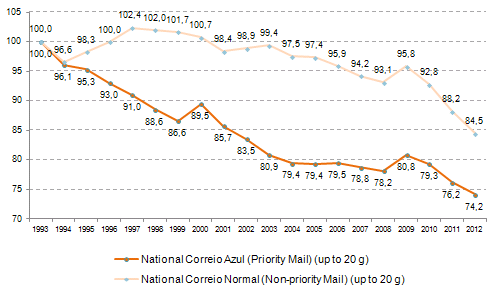
Source: ICP-ANACOM.
7.2.3. Quality of the universal postal service
As in the case of the Price Convention, the Quality Convention concluded between ICP-ANACOM and CTT on 10 July 2008 (as amended on 10 September 2010), also remains in force on a temporary basis, until ICP-ANACOM determines the quality of service parameters and performance targets associated with provision of the universal service (as set out in paragraph 2 of article 13 of the Postal Law).
The Quality Convention defines a set of quality of service indicators (QSI) and respective quality levels, which CTT undertakes to accomplish annually (see Table 8). The Convention also establishes a global indicator of quality of service (GI), which is calculated based on the levels of quality of service accomplished by CTT in respect of the above QSI6.
In this context, and pursuant to its objective to assure and protect the rights of users and citizens, ICP-ANACOM monitored the QSI of CTT on a quarterly basis and, in late 2012, made an evaluation of compliance in light of the stipulations of the Quality Convention.
In 2012, target values were achieved for all QSI, and the GI was reported with a value exceeding one hundred (see Table 8).
In the event of non-compliance with stipulated quality levels, the Quality Convention7 determines the application of a deduction with respect to the prices of reserved services allowed for the year following the respective lack of compliance (maximum deduction of 1 percentage point). In exceptional situations duly substantiated by CTT and where there are operational difficulties in implementing the price reduction, the deduction in prices may be substituted by alternative actions to compensate customers, where approved by ICP-ANACOM, having a financial value identical to that resulting from lower prices.
Since the GI exceeds one hundred and all QSI exceeded their corresponding minimum values, no deduction has been applied to the maximum variation in prices allowed for reserved services in 2013.
|
Quality of service indicators |
Quality Convention |
Quality of service |
|||
|
RI |
Established value |
||||
|
Min. |
Target |
||||
|
QSI1 |
Transit time for Non-Priority Mail (D+3) |
45.0% |
95.5% |
96.3% |
98,0% |
|
QSI2 |
Transit time for Priority Mail - Mainland (D+1) |
15.0% |
93.5% |
94.5% |
94,9% |
|
QSI3 |
Transit time for Priority Mail - CAM (D+2) |
4.0% |
84.0% |
87.0% |
94,2% |
|
QSI4 |
Non-priority mail not delivered within 15 working days |
5.0% |
2.3‰ |
1.4‰ |
1,4‰ |
|
QSI5 |
Priority mail not delivered within 10 working days |
3.0% |
2.5‰ |
1.5‰ |
1,5‰ |
|
QSI6 |
Transit time for Newspapers and Periodicals (D+3) |
11.0% |
95.5% |
96.3% |
97,3% |
|
QSI7 |
Transit time for Intra-community cross-border mail (D+3) |
3.5% |
85.0% |
88.0% |
94,8% |
|
QSI8 |
Transit time for intra-community cross-border mail (D+5) |
3.5% |
95.0% |
97.0% |
99,2% |
|
QSI9 |
Transit time for non-priority parcels (D+3) |
5.0% |
90.5% |
92.0% |
96,7% |
|
QSI10 |
Waiting time at postal establishments |
5.0% |
75.0% |
85.0% |
90,9% |
|
GI - Indicator of overall quality of service (b) |
N/A |
N/A |
N/A |
N/A |
|
Notes: D+X, means delivery to the recipient up to X working day(s) following deposit of the item in a mail reception point. RI - relative importance. Min. - Minimum value. Target - Target value. N/A - Not applicable.
Source: (a) CTT. Unaudited figures. (b) ICP-ANACOM Calculation.
For the purposes of calculating the QSI defined in the Quality Convention, the above QSI values for 2012 incorporate the deduction of records referring to correio normal (non-priority mail) and correio azul (priority mail) impacted by the general strikes held on 22 March 2012 (determination of July 5, 2012) and on 14 November 2012 (determination of 7 February 2013).
As seen in Graph 16, the GI has been improving since 1997 - a trend only interrupted in 2003 and 2006, when values under 100 points were reported.
Graph 16. Indicator of overall quality of service - GI

Note: Since the value of the GI is based on individual results of QSI, when comparing the GI over time, it is important to take into account changes in the QSI defined for each year level and in the methodology used when calculating them.
Source: ICP-ANACOM calculations.
ICP-ANACOM also conducted monitoring, on a quarterly basis, of indicators on the complaints which CTT receives about the universal service.
In 2012, CTT responded to 50,196 complaints about the universal postal service (providing response in an average of 17.5 days), and to 39,582 requests for information about the universal service. Although the majority of complaints and enquiries received were about the national service, most of the complaints that resulted in compensation for services provided referred to international services.
|
Category |
Complaints |
Enquiries |
Processes received in year |
|||
|
Answered in the year |
Answered in the year leading to payment of compensation |
Average response time (calendar days) |
Answered in year |
Average response time (calendar days) |
||
|
Total |
50 196 |
7 674 |
17.5 |
39 582 |
13.4 |
91 097 |
|
National |
32 798 |
1 676 |
7.9 |
21 597 |
4.6 |
54 369 |
|
International |
17 398 |
5 998 |
35.5 |
17 985 |
24.1 |
36 728 |
Source: CTT (unaudited values).
In addition to the periodic monitoring of quality levels achieved by CTT throughout the year, ICP-ANACOM ensures, independently of the universal service provider, quality level monitoring for the services actually provided, in order to guarantee accuracy.
In this context, at the beginning of 2013, ICP-ANACOM released the findings of the audit conducted in 2012 on the quality of service indicators, complaints and enquiries reported by CTT with reference to 2010. A further audit was conducted in 2012, on quality of service indicators, complaints and enquiries reported by CTT with reference to 2011; the conclusions of this audit and details of subsequent actions will be published in 2013.
In comparative terms, based on the data of a report from the European Regulators Group for Postal Services (ERGP) - ERGP Report on the quality of service and end-user satisfaction, published at the end of 2012, positive performance was reported for the indicator "priority mail transit time" in the Portuguese case for the relevant year (2011); the reported value exceeded the target set in the Quality Convention and is one of the highest found among EU Member States, in terms of both target value and accomplished value.
Graph 17. Comparison between target and accomplished
values in priority mail transit time, 2011
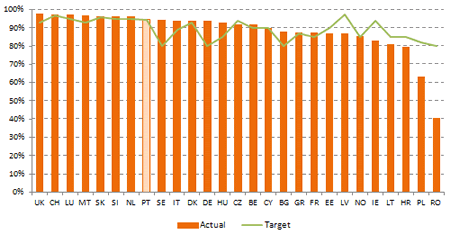
Source: ICP-ANACOM, based on the data from ERGP Report on the quality of service and end-user satisfaction, published at the end of 2012.
7.2.4. Network of postal establishments
According to paragraph 3 of base XX of the Concession, the concessionaire is responsible for the establishment and closure of postal establishments and the changing of their working hours, taking into account service needs and levels of demand.
CTT is required to inform ICP-ANACOM on decisions taken in this regard, and in cases of closure and reduction of opening hours of post offices, to give basis to such decisions, especially in terms of service needs, levels of demand and satisfaction of the communication needs of the population and of economic activities.
In this context, in 2012, notifications were received from CTT with reference to 82 post offices, as follows:
- Closure of 5 post offices.
- Closure of 31 post offices, replaced by postal agencies.
- Establishment of 2 post offices.
- Reduction in opening hours affecting 38 post offices;
- Extension of opening hours affecting 6 post offices.
In 2012, the total number of postal establishments was little changed from the previous year. This situation results from an increase in the number of postal agencies, offsetting the continued reduction (since 2002) in the number of post offices (see graph below).
Graph 18. Number of postal establishments

Source: CTT. Values at the end of each year.
Based on data available from UPU on the networks of permanent postal establishments belonging to the universal service providers in EU Member States (with reference to 2011), it can be concluded that the situation in Portugal compares favourably with the EU average (excluding Portugal), both in terms of postal coverage (see Graph 19) and in terms of network density index (see Graph 20).
Graph 19. Coverage of permanent postal establishments in the
EU Member States in 2011 (km2 per postal establishment)
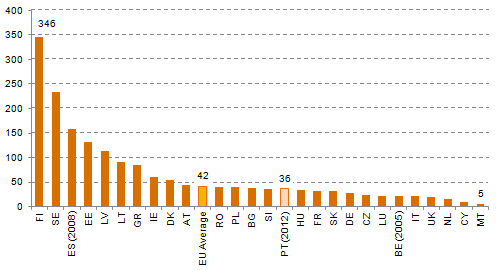
Note: For countries where 2011 data was not available, most recent available data from the UPU was used (reference year in brackets). EU average without Portugal. PT (2012): Value for Portugal as at the end of 2012.
Source: UPU.
Graph 20. Density of postal establishments in EU Member States
in 2011 (population per postal establishment)
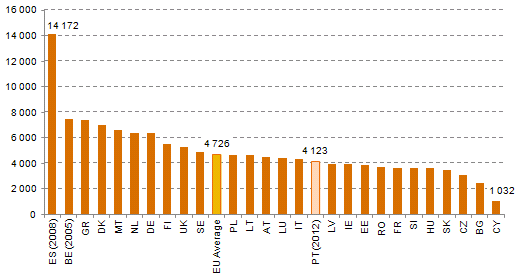
Note: For countries where 2011 data was not available, the most recent available data from the UPU was used (reference year in brackets). EU average without Portugal. PT (2012): Value for Portugal as at the end of 2012.
Source: UPU.
In Portugal, about 71% of permanent postal establishments are managed by third parties - above the EU average of 46%. In any case, according to the data available from the UPU, the percentage of postal establishments managed by third parties is higher than in Portugal in eight Member States - see Graph 21.
Graph 21. Relative importance of permanent postal
establishments managed by third parties (2011)
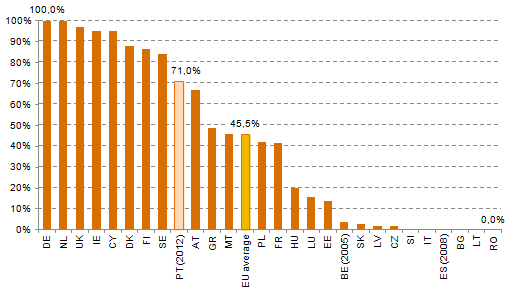
Note: For countries where 2011 data were not available, the most recent available data from the UPU was used (reference year in brackets). EU average without Portugal. PT (2012): Value for Portugal as at the end of 2012.
Source: UPU.
1 While the delivery of postal packages received from other Member States of the European Union and weighing up to twenty kilograms remains within the universal service as mentioned above.
2 ICP-ANACOM Determination of 28 June 2012.
3 ICP-ANACOM Determination of 6 September 2012, rectified on 13 September 2012.
4 Year in which the first Price Convention agreed between ICP-ANACOM, CTT and the then DGCC - Direcção-Geral do Comércio e da Concorrência (Directorate General of Commerce and Competition) was in force.
5 The prices considered are those of: stamps and franking at the post office counter; items sent according to flat-rate fee; stamps in vending machines (1 and 10 units). In calculating average annual prices, a fixed traffic structure is used, corresponding to 2011. The calculation of the actual trend in the price index took each year's inflation rate into account, as reported by INE - Instituto Nacional de Estatística (Statistics Portugal).
6 The GI is calculated as follows: 1) a classification is assigned to each QSI established in the Quality Convention in accordance with the following methodology: i) With the verification that the accomplished value is equal to the value established for each QSI, a value of 100 is assigned to the QSI, ii) if the amount accomplished is less than the minimum value, a value of 0 is assigned to the QSI, iii) if the realized value is between the minimum and the target, a proportional value of between 0 and 100 is assigned to the QSI, iv) for values above the target, the classification will be more than 100 in proportion to the positive difference achieved for the objective. 2.) Sum of the classifications assigned to each QSI, weighting them according to their relative importance. 3) if the GI is: i) 100 or more there will be no deduction associated with the GI; ii) If it is less than 90 the full deduction of one percentage point shall be applied; iii) if it is between 90 and 100, the deduction shall be applied proportionately.
7 In article 6, paragraph 1 of the Quality Convention, it is established that in the event that any situations occur of force majeure or in the event of phenomena which are clearly outside the control of CTT and which have an impact on the quality of service provided by CTT, the latter may request the deduction of the records for the periods of time and geographic flows impacted, for the purpose of calculating the QSI, The decision on whether or not to grant the request falls to ICP-ANACOM.




